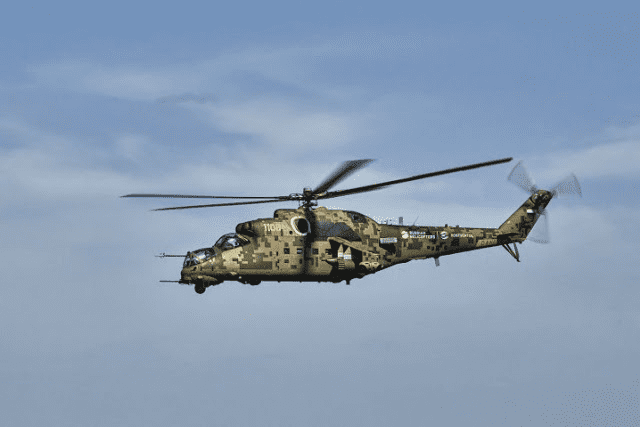For every class of military equipment, there is usually a standard, an icon that sets the benchmark which others follow. For assault rifles; it is the Kalashnikov AK-47, for main battle tanks; the T-72, and then for helicopter gunship; the Russian-built Mi-35 Hind.
All three systems rewrote the playbook on warfare in their various department, but the most notable is the Russian-built Mi-35 Hind attack helicopter – a heavily armed gunship fitted with immense armor and designed to be survivable even in the most contested environment.

Prowling the skies of countries around Africa, and the Middle East, looking for terrorists, and other bad elements is the Mi-35 Hind helicopter gunship a.k.a “flying tank”.
This ubiquitous Cold War helicopter first flew in the 1970s for the Soviet Union, has taken part in numerous conflicts across the Middle East and Africa, and has even been featured in movies, such as 1984’s “Red Dawn.”
The Nigerian Air Force (NAF) is a prolific user of the Mi-35 Hind and its older cousin the Mi-24, both platforms have earned the praise of the NAF pilots.
A documentary video was recently released by the NAF, showing the Mi-35 Hind in its natural element in the warzone of northeastern Nigerian. The Hind carry out the bulk of the air combat sorties against insurgents, terrorists, and bandits across the West African country.
The Nigerian Air Force plans to upgrade three of its older Mi-35 helicopters to the new Mi-35P Phoenix being offered by Rosoboronexport.
The Nigerian Air Force operates several variants of around fifteen Mi-24/35 Hind helicopters including two second-hand Mi-35P received from Belarus in 2010, two Mi-35P and one Mi-24V from Ukraine in 2008 and 2014, six second-hand but modernized Mi-35P and eight Mi-35M received from Russia in 2000 and 2012-14 respectively.

A haul of twelve brand new Mi-35Ms was ordered from Russian Helicopters in September 2015. Two were delivered in April 2017, another two helicopters arrived the next year.
On the other hand, the newer Mi-35M and P variant is one of the modern combat helicopters in the world, the helicopter integrates modern, high-precision weaponry for destroying ground-based armored targets and providing air support for ground missions. It can be tasked attack, ground assault, medical evacuation (MEDEVAC), or transport roles.
The new Mi-35P helicopter was first presented to African nations at the Russia-Africa Economic Forum in Sochi in 2019.
The vastly modernized Mi-35 version is a 9-ton helicopter with a maximum speed of about 200 miles per hour, and armed with a staggering amount of firepower: a combination of 12.7-millimeter machine guns, 23-millimeter and 30-millimeter cannon, plus three hardpoints on each of its two stubby wings to mount rocket pods, anti-tank missiles or bombs.
The stub wings can carry a range of weapon systems including anti-tank missiles, rocket pods/gun pods, or fuel tanks, including up to eight 9М114 or 9M120 Ataka-V SACLOS radio guided anti-tank missiles, up to 80 ‘S-8’ 80mm unguided rockets and 20 ‘S-13’ type 122mm unguided aircraft rockets.
The chin-mounted turret can be installed with the twin-barrel GSh-23V 23mm cannon with 450 to 470 rounds of ammunition. The gun can fire 3,400 to 3,600 rounds a minute.
Even with it’s immense firepower, the Mi-35 carries eight infantrymen into battle, thus the Hind is an attack helicopter that brings its own infantry support (or a transport helicopter that brings its own fire support).
Russia considers the Hind an “assault helicopter”, nevertheless, in most cases, the helicopters usually operated as an attack helicopter.
The Mi-35 Hind is equipped with highly advanced sensors that enable it to conduct day and night operations, in all weather conditions.
The glass cockpit of the Mi-35M accommodates two pilots in tandem configuration. The night vision goggle (NVG)-compatible cockpit integrates multi-functional displays (MFDs), redundant flight controls and state-of-the-art avionics.
The helicopter is equipped with an OPS-24N surveillance-and-sighting station, a television channel, a GPS-guided navigation system and an optional non-Russian radio station.
The Hind has enjoyed much popularity, and in Africa today, not less than twenty-five countries field the Mi-24/35 Hind in their armed forces, including Algeria, Angola, Burkina Faso, Burundi, Chad, Republic of Congo, Democratic Republic of Congo, Djibouti, Egypt, Equatorial Guinea, Eritrea, Ethiopia, Guinea, Libya, Mali, Mozambique, Namibia, Niger, Nigeria, Rwanda, Senegal, Sierra Leone, Sudan, Uganda, Zimbabwe.




